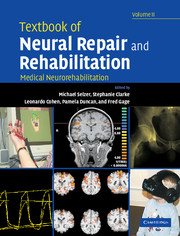Book contents
- Frontmatter
- Contents
- Preface
- Contributors
- Contributors
- Neural repair and rehabilitation: an introduction
- Section A Technology of neurorehabilitation
- Section A1 Outcomes measurement and diagnostic technology
- 1 Outcomes measurement: basic principles and applications in stroke rehabilitation
- 2 Human voluntary motor control and dysfunction
- 3 Assessments, interventions, and outcome measures for walking
- 4 Electromyography in neurorehabilitation
- 5 Functional neuroimaging
- Section A2 Therapeutic technology
- Section B Symptom-specific neurorehabilitation
- Section B1 Sensory and motor dysfunctions
- Section B2 Vegetative and autonomic dysfunctions
- Section B3 Cognitive neurorehabilitation
- Section C Disease-specific neurorehabilitation systems
- Index
- Plate section
1 - Outcomes measurement: basic principles and applications in stroke rehabilitation
from Section A1 - Outcomes measurement and diagnostic technology
Published online by Cambridge University Press: 04 August 2010
- Frontmatter
- Contents
- Preface
- Contributors
- Contributors
- Neural repair and rehabilitation: an introduction
- Section A Technology of neurorehabilitation
- Section A1 Outcomes measurement and diagnostic technology
- 1 Outcomes measurement: basic principles and applications in stroke rehabilitation
- 2 Human voluntary motor control and dysfunction
- 3 Assessments, interventions, and outcome measures for walking
- 4 Electromyography in neurorehabilitation
- 5 Functional neuroimaging
- Section A2 Therapeutic technology
- Section B Symptom-specific neurorehabilitation
- Section B1 Sensory and motor dysfunctions
- Section B2 Vegetative and autonomic dysfunctions
- Section B3 Cognitive neurorehabilitation
- Section C Disease-specific neurorehabilitation systems
- Index
- Plate section
Summary
Summary
The objective of this chapter is to give an overview of basic principles guiding the development and application of outcome measures. This chapter starts by introducing basic concepts related to the development of outcome measures, and demonstrates their applications in stroke rehabilitation. Specifically, the first section includes a theoretical discussion of reliability, validity and responsiveness, and how to approach interpretation. This discussion is based on classical test theory. For each property the theory is applied to development of a measure of “participation”. Future trends related to computer-adapted testing (CAT) are also briefly described. In the second section, the evaluation of “walking competency” after stroke is used to illustrate the selection of appropriate outcome measures for this population, as well as their relation to “participation”. These measures include self-reported scales, performance-based ratings and laboratory assessments. This chapter concludes with examples of how laboratory-based gait assessments and measures of brain reorganization help explain changes in clinical scales and performance-based measures.
Introduction
“Outcomes are the end results of medical care: what happened to the patient in terms of palliation, control of illness, cure or rehabilitation” (Brook et al., 1976). Outcome measures used in stroke rehabilitation can be divided into three categories: scales that assess constructs such as function, mobility and quality of life, performance-based measures that evaluate such areas as gait speed and upper limb dexterity, and measures of brain plasticity. This chapter introduces basic concepts related to the development of outcome measures and demonstrates their applications in stroke rehabilitation.
Keywords
- Type
- Chapter
- Information
- Textbook of Neural Repair and Rehabilitation , pp. 5 - 23Publisher: Cambridge University PressPrint publication year: 2006

